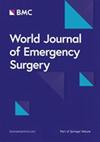Ultrasonic dissection versus electrocautery dissection in laparoscopic cholecystectomy for acute cholecystitis: a randomized controlled trial (SONOCHOL-trial)
IF 5.8
1区 医学
Q1 EMERGENCY MEDICINE
引用次数: 0
Abstract
Laparoscopic cholecystectomy with ultrasonic dissection presents a compelling alternative to conventional electrocautery. The evidence for elective cholecystectomy supports the adoption of ultrasonic dissection, citing advantages such as reduced operating time, diminished bleeding, shorter hospital stays and decreased postoperative pain and nausea. However, the efficacy of this procedure in emergency surgery and patients diagnosed with acute cholecystitis remains uncertain. The aim of this study was to compare outcomes of electrocautery and ultrasonic dissection in patients with acute cholecystitis. A randomized, parallel, double-blinded, multicentre controlled trial was conducted across eight Swedish hospitals. Eligible participants were individuals aged ≥ 18 years with acute cholecystitis lasting ≤ 7 days. Laparoscopic cholecystectomy was performed in the emergency setting as soon as local circumstances permitted. Random allocation to electrocautery or ultrasonic dissection was performed in a 1:1 ratio. The primary endpoint was the total complication rate, analysed using an intention-to-treat approach. The primary outcome was analysed using logistic generalized estimated equations. Patients, postoperative caregivers, and follow-up personnel were blinded to group assignment. From September 2019 to March 2023, 300 patients were enrolled and randomly assigned to electrocautery dissection (n = 148) and ultrasonic dissection (n = 152). No significant difference in complication rate was observed between the groups (risk difference [RD] 1.6%, 95% confidence interval [CI], − 7.2% to 10.4%, P = 0.720). No significant disparities in operating time, conversion rate, hospital stay or readmission rates between the groups were noted. Haemostatic agents were more frequently used in electrocautery dissection (RD 10.6%, 95% CI, 1.3% to 19.8%, P = 0.025). Ultrasonic dissection and electrocautery dissection demonstrate comparable risks for complications in emergency surgery for patients with acute cholecystitis. Ultrasonic dissection is a viable alternative to electrocautery dissection or can be used as a complementary method in laparoscopic cholecystectomy for acute cholecystitis. The trial was registered prior to conducting the research on http://clinical.trials.gov , NCT03014817.腹腔镜胆囊切除术治疗急性胆囊炎时超声波剥离与电烧剥离:随机对照试验(SONOCHOL-试验)
超声波剥离腹腔镜胆囊切除术是传统电烧术的一个令人信服的替代方案。有证据表明,选择性胆囊切除术具有缩短手术时间、减少出血、缩短住院时间、减轻术后疼痛和恶心等优点,因此支持采用超声波剥离术。然而,该手术在急诊手术和急性胆囊炎患者中的疗效仍不确定。本研究旨在比较急性胆囊炎患者接受电灼术和超声波剥离术的疗效。瑞典的八家医院开展了一项随机、平行、双盲、多中心对照试验。符合条件的参与者为年龄≥ 18 岁、急性胆囊炎持续时间≤ 7 天的患者。在当地条件允许的情况下,尽快在急诊室进行腹腔镜胆囊切除术。以1:1的比例随机分配电灼术或超声波剥离术。主要终点是总并发症发生率,采用意向治疗法进行分析。主要结果采用逻辑广义估计方程进行分析。患者、术后护理人员和随访人员对组别分配保密。从2019年9月到2023年3月,300名患者入组并随机分配到电烧剥离(n = 148)和超声波剥离(n = 152)。两组患者的并发症发生率无明显差异(风险差异 [RD] 1.6%,95% 置信区间 [CI],- 7.2% 至 10.4%,P = 0.720)。两组在手术时间、转换率、住院时间或再入院率方面无明显差异。止血剂更常用于电烧剥离(RD 10.6%,95% CI,1.3% 至 19.8%,P = 0.025)。在急性胆囊炎患者的急诊手术中,超声波剥离和电烧剥离的并发症风险相当。在急性胆囊炎的腹腔镜胆囊切除术中,超声波剥离是电烧剥离的可行替代方法,也可作为一种补充方法。该试验在进行研究之前已在 http://clinical.trials.gov , NCT03014817 上注册。
本文章由计算机程序翻译,如有差异,请以英文原文为准。
求助全文
约1分钟内获得全文
求助全文
来源期刊

World Journal of Emergency Surgery
EMERGENCY MEDICINE-SURGERY
CiteScore
14.50
自引率
5.00%
发文量
60
审稿时长
10 weeks
期刊介绍:
The World Journal of Emergency Surgery is an open access, peer-reviewed journal covering all facets of clinical and basic research in traumatic and non-traumatic emergency surgery and related fields. Topics include emergency surgery, acute care surgery, trauma surgery, intensive care, trauma management, and resuscitation, among others.
 求助内容:
求助内容: 应助结果提醒方式:
应助结果提醒方式:


